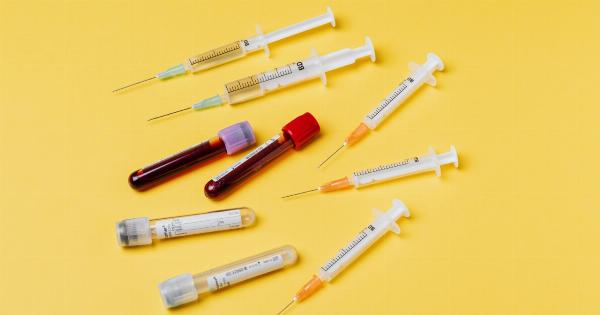Blood transfusion is a life-saving medical intervention that involves transferring blood or blood products from a donor to a recipient.
While this procedure is generally considered safe and beneficial, there are specific considerations when it comes to a female donor and a male recipient. In this article, we will explore the potential risks and complications associated with a female donor-male recipient blood transfusion.
Compatibility and Blood Types
Blood transfusions require compatibility between the donor and recipient’s blood types. There are four major blood types: A, B, AB, and O.
Each blood type has specific antigens on red blood cells that can trigger an immune response if they are incompatible. For example, a person with blood type A has A antigens on their red blood cells and anti-B antibodies in their plasma.
ABO Incompatibility
When the blood types of the donor and recipient are incompatible, the recipient’s immune system may recognize the transfused blood as foreign and mount an immune response. This can lead to various complications, ranging from mild to severe.
ABO incompatibility reactions can cause symptoms such as fever, chills, shortness of breath, jaundice, and in severe cases, kidney failure or even death.
Rh Incompatibility
Apart from the ABO blood types, another important consideration is the Rh factor. This refers to the presence or absence of the Rh antigen on red blood cells.
If a male recipient is Rh-negative and receives blood from an Rh-positive female donor, it can lead to Rh incompatibility. This is particularly relevant in cases where the recipient may require multiple blood transfusions over time.
Hemolytic Disease of the Newborn (HDN)
One of the most serious complications of Rh incompatibility is Hemolytic Disease of the Newborn (HDN). If a pregnant woman is Rh-negative and her fetus is Rh-positive, there is a risk of sensitization.
During pregnancy or childbirth, fetal blood cells may enter the mother’s bloodstream, causing her immune system to produce antibodies against Rh-positive blood. In subsequent pregnancies, these antibodies can cross the placenta and attack the red blood cells of the fetus, leading to HDN.
Immunologic Reactions
Immunologic reactions are a potential complication in any blood transfusion, regardless of the donor’s gender.
The recipient’s immune system may react to any foreign substances in the donated blood, including white blood cells, plasma proteins, or minor blood group antigens. These reactions can range from mild allergic reactions to severe immune-mediated conditions such as transfusion-related acute lung injury (TRALI) or transfusion-associated graft-versus-host disease (TA-GVHD).
Transfusion-Transmitted Infections
Infections can also be transmitted through blood transfusions. While extensive screening measures are in place to reduce the risk, some infections can still go undetected.
Examples of transfusion-transmitted infections include hepatitis B and C, HIV, West Nile virus, and syphilis. It is essential to thoroughly test all donated blood to minimize the chances of infection transmission.
Iron Overload
Repeated blood transfusions, especially in patients with chronic conditions such as thalassemia or sickle cell disease, can lead to iron overload.
Iron is an essential component of hemoglobin, and each transfusion introduces additional iron into the recipient’s body. Over time, excess iron can accumulate in organs such as the liver, heart, and endocrine glands, causing various complications, including organ damage and dysfunction.
Transfusion-related Acute Lung Injury (TRALI)
TRALI is a rare but potentially life-threatening complication of blood transfusion. It is characterized by the rapid onset of respiratory distress, often within six hours of transfusion.
Although the exact mechanism is not fully understood, TRALI is believed to occur due to an immune response triggered by antibodies present in the donor’s plasma. This immune response can lead to inflammation and increased permeability of the lung’s blood vessels.
Transfusion-associated Graft-versus-Host Disease (TA-GVHD)
TA-GVHD is another rare but severe complication of blood transfusion. It occurs when the infused donor lymphocytes recognize the recipient’s tissues as foreign and mount an immune response.
This immune reaction can lead to damage in various organs and tissues, similar to an actual graft-versus-host disease seen in bone marrow transplantation. TA-GVHD has a high mortality rate and is considered a medical emergency.
Preventing Complications
To minimize the risks and complications associated with female donor-male recipient blood transfusion, several strategies can be implemented. Thorough screening of donors and donated blood is crucial to detect any potential infections or other risks.
In specific cases, special blood products, such as irradiated blood, can be used to reduce the risk of TA-GVHD. Additionally, close monitoring of the recipient during and after transfusion can help identify any adverse reactions promptly.
Conclusion
While blood transfusions are generally safe and life-saving, there are unique considerations when it comes to a female donor-male recipient scenario.
ABO and Rh incompatibilities, HDN, immunologic reactions, transfusion-transmitted infections, iron overload, TRALI, and TA-GVHD are potential risks and complications that must be carefully managed. By implementing rigorous screening measures, compatible blood typing, and constant monitoring, healthcare professionals can ensure the safety and well-being of patients receiving blood transfusions.





























